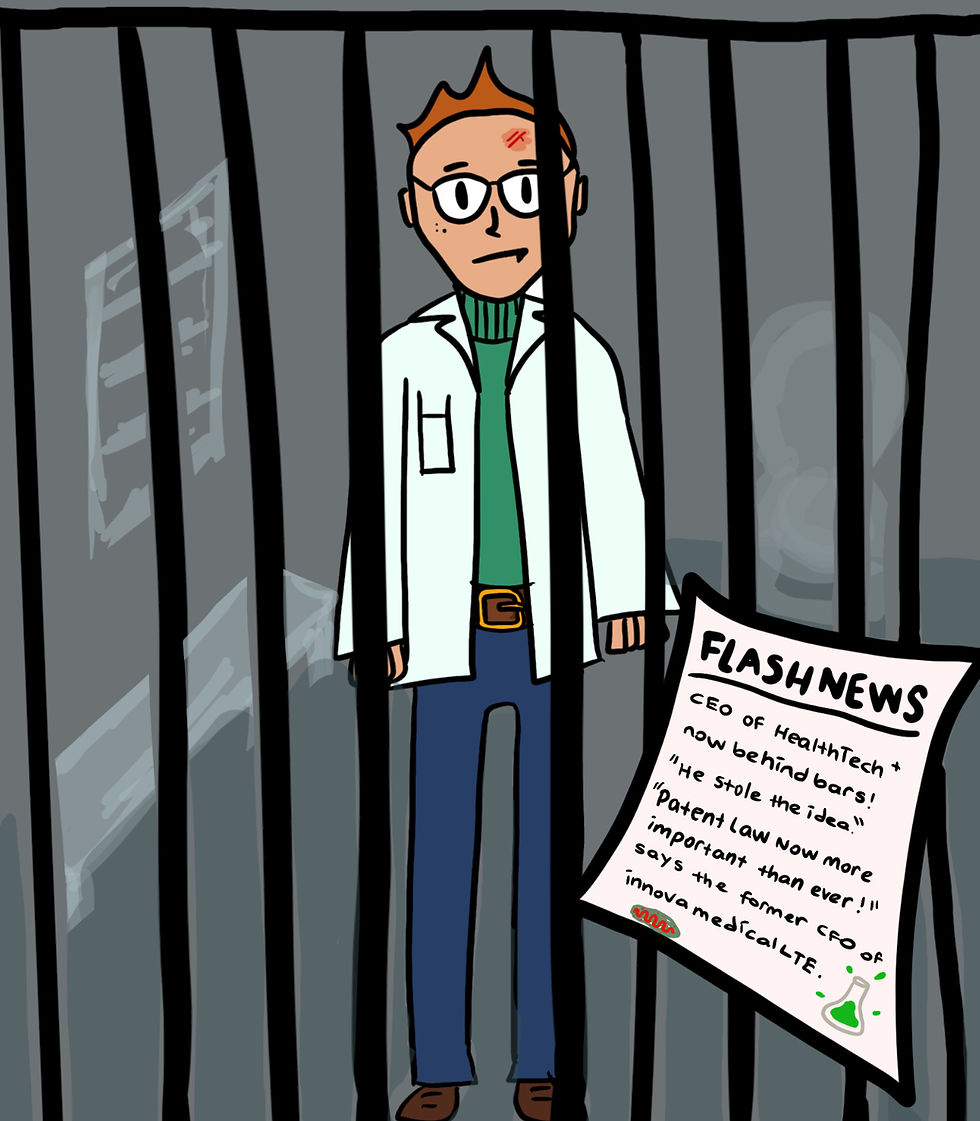The Young & Lonely: A Look into the Impact of the Loneliness Epidemic Amongst College Students
- Roma Yi
- Jan 14
- 7 min read
Written by: Roma YI
Edited by: Ava Hargrave, Akshay Pokala, and Nicole Serrano
Illustrated by: Alicia Chang

On May 23, 2023, U.S. Surgeon General, Vivek Murthy, released the country’s annual health advisory on the largest major public health issue the nation was facing. Unlike previous advisories, this one did not mention a biological agent, novel carcinogen, or horrifying virulent disease, but rather a more harmful condition that was plaguing individuals without their knowledge: loneliness. The 2022 COVID-19 pandemic forced America into a level of uncertainty unlike no other and halted what one may consider the “normal way of life” for millions. On micro-levels, internal social structures like friend groups amongst the elderly and community centers where young children would interact and convene were strained by the lack of physical contact and interaction. As communities were forced into isolation, people yearned for more connection but could not fulfill those needs due to strict social distancing guidelines and quarantine procedures. These conditions served as the foundation for the loneliness epidemic we see now. The U.S. Public Health Service defines loneliness as “a subjective distressing experience that results from perceived isolation or inadequate meaningful connections” [1]. While one can feel “alone,” those moments are transient compared to the chronic longing for social connection that marks “loneliness” as a more severe state.
The demographics most at risk for these deleterious effects were adolescents and young adults [1]. While the highest rates of social isolation are found among older adults, young adults are almost twice as likely to report feeling lonely than those over 65 [1]. With the advent of social media, one might assume that young adults would be protected from the effects of social isolation and loneliness; however the lack of physical interaction and engagement social media presents has seemingly led to a hesitancy in young adults to engage with others in a meaningful way [2]. This claim is supported by various physicians featured in the American Medical Association’s “What Doctors Wish Patients Knew” series, noting a lack of connectivity amongst specifically younger people [2]. This decline in connectivity is observed most in young people ages 15 to 24, which coincides with the age groups found in college universities [1]. The increased reliance on social media, increases in mental health conditions, and lack of overall community are a few of the multitude of reasons why young people have been more severely affected by the loneliness epidemic [3]. The young adolescents of today are in truly unprecedented times where they suffer from a lack of social cohesion, and by the time they enter college, these feelings tend to exacerbate.
Earlier this September, a staff writer for the Yale News, Fareed Salmon, addressed this topic amongst the undergraduate Yale population as he noticed these statistics playing out in real-time:
On college campuses like Yale, the grind for some students is getting into a particular grad school or attaining a great job after graduation. This can easily lead to the deprioritization of deep friendships and interactions with the community [4].
The deprioritization of human interaction is a sentiment shared in online spaces and those with a “hustle” mindset. The notion of being “unfazed and unbothered” seems to have been amplified following the pandemic as well. Yet upon further inspection, one can also see how these mentalities and asocial expressions might also serve as a coping mechanism for those disconnected from a cohesive community. During the COVID-19 pandemic, social media and online spaces were touted as the solution to feelings of isolation and disconnection. However, they seem to have only embellished the hazardous effects. In a meta-analysis of 14 different papers, Youngwrong Lee et al. found that “excessive time spent on social media platforms was associated with a greater likelihood of having symptoms of anxiety and depression” [5]. Like any unhealthy coping mechanism, many users may initially use social media platforms to manage stress or other negative emotions; yet, over time these same self-soothing mechanisms become harmful and only offer more damage and replace the initial delight that first came with it [6]. Social media algorithms are designed to encourage engagement between the viewer and the app to keep them coming back for more. Recent literature has come out detailing the mechanisms behind how technology manipulates people into these cycles and how young children and adolescents are most at risk [7].
The insidious effects of social media use are simply a small piece of the multidimensional aspect of loneliness, yet these effects highlight the more pressing issue of negative mental health effects amongst young college students that this epidemic pushed to unprecedented levels. Depression and anxiety have become the two major mental health conditions that plague Gen X [5]. These conditions have ancient histories that one may even see as an inevitability in life due to how intertwined with the human condition they seem to be. Yet, the level of prevalence in today’s age amongst young college students is still striking and of notable distinction. In a study by Dr. Lee stated that “college students and frontline healthcare workers [during and after the pandemic], bore a disproportionate burden of mental health problems worldwide (e.g., high levels of anxiety and depression), highlighting the need for appropriate intervention in these populations” [5]. These effects do not exist in a vacuum, as a review of 63 studies published by the International Journal of Environmental Research and Public Health concluded that loneliness and social isolation among children and adolescents increase the risk of depression and anxiety and that this risk remained high even up to nine years later [3]. Furthermore, according to a recent survey from The Healthy Minds Network (HMN), a nationally recognized premier research organization dedicated to the health and well-being of adolescents, “44% of students reported symptoms of depression, 37% reported anxiety disorders and 15% reported having seriously considered suicide in the past year—the highest recorded rates in the history of the 15-year-old survey” [8]. It’s important to note that the HMN only considers college students for these surveys as they release them to academic institutions and universities. Many young people who cannot afford to go to college or forfeit their education tend to face higher levels of depression and anxiety in comparison [9]. Those in lower socioeconomic classes tend to have worse mental health overall compared to their peers for reasons that range from more stress, less autonomy, poorer living conditions, and the other burdens associated with the cost of poverty [9].
The negative effects of loneliness are not only mental but physical, too. In a synthesis of longitudinal studies, the 2023 Public Health Advisory found that “poor social relationships (social isolation, poor social support, loneliness) were associated with a 29% increase in the risk of heart disease and a 32% increase in the risk of stroke” [1]. Further, the same study found that the risks associated with poor social relationships often begin early in life and sustain for one’s entire lifetime. In addition, the 2023 Public Health Advisory stated the negative effects of loneliness on physical health include “smoking 15 cigarettes a day or having six drinks daily” and “worse management of chronic health conditions like type 2 diabetes” [1]. Other physical side effects of loneliness include poor sleep quality, declines in cognition, and increased overall mortality [10]. The medical healthcare system has made major strides to publicly address and confirm that negative mental health effects have an impact on us as individuals, which makes one wonder: why is there a lack of acknowledgement from the group that suffers from it the most?
Current undergraduate students have been effectively robbed of the carefree attitudes that were once emblematic of the college experience pre-pandemic. To say that is a tragedy would be an understatement. The “digital age” has transformed the social landscape into a place where competition is ever present, but connection remains scarce. The general lack of comment on this condition could be attributed to a more closed-off social environment and/or the vast amount of responsibilities that boulder on the shoulders of young people. Truly an unbeatable wonder that has no winners. Regardless of the cause, the effects of loneliness amongst young people are an ever-present reality that we have a collective duty to ameliorate. The tasks are simple: say “hi” to classmates you see often, catch up with schoolmates in real life, and engage with others in a meaningful way. Though the initial cost may involve social anxiety or awkwardness, the rewards of building a community and social fabric far outweigh these challenges.
References
[1] U.S. Public Health Service. (2023). Our epidemic of loneliness and isolation: The U.S. Surgeon General’s advisory on the healing effects of social connection and community [Internet]. National Center for Biotechnology Information. https://pubmed.ncbi.nlm.nih.gov/37792968/
[2] Berg, S. (2023, July 14). What doctors wish patients knew about loneliness and health. American Medical Association. Retrieved from https://www.ama-assn.org/delivering-care/public-health/what-doctors-wish-patients-knew-about-loneliness-and-health
[3]Bozzola, E., Spina, G., Agostiniani, R., Barni, S., Russo, R., Scarpato, E., Di Mauro, A., Di Stefano, A. V., Caruso, C., Corsello, G., & Staiano, A. (2022). The use of social media in children and adolescents: Scoping review on the potential risks. International Journal of Environmental Research and Public Health, 19(16), 9960. https://doi.org/10.3390/ijerph19169960
[4] Salmon, F. (2024, September 30). How the “Loneliness epidemic” is impacting Yale students. Yale Daily News. Retrieved from https://yaledailynews.com/blog/2024/09/29/how-the-loneliness-epidemic-is-impacting-yale-students/
[5] Lee, C. (2023, March 27). Latest federal data show that young people are more likely than older adults to be experiencing symptoms of anxiety or depression. KFF. Retrieved from https://www.kff.org/mental-health/press-release/latest-federal-data-show-that-young-people-are-more-likely-than-older-adults-to-be-experiencing-symptoms-of-anxiety-or-depression/
[6] Heilig, M., MacKillop, J., Martinez, D., Rehm, J., Leggio, L., & Vanderschuren, L. J. M. J. (2021, February 22). Addiction as a brain disease revised: Why it still matters, and the need for consilience. Nature News. https://www.nature.com/articles/s41386-020-00950-y
[7] Hansen, K. (2022, October 17). Our social media addiction. Harvard Business Review. https://hbr.org/2022/11/our-social-media-addiction
[8] Heinze, J. (2023, March 9). College students’ anxiety, depression higher than ever, but so are efforts to receive care. University of Michigan School of Public Health: Mental Health: Healthy Minds Study. Retrieved from https://sph.umich.edu/news/2023posts/college-students-anxiety-depression-higher-than-ever-but-so-are-efforts-to-receive-care.html#:~:text=It%20found%20that%2044%25%20of,15%2Dyear%2Dold%20survey
[9] Kondirolli, F., & Sunder, N. (2022). Mental health effects of education. Health economics, 31 Suppl 2(Suppl 2), 22–39. https://doi.org/10.1002/hec.4565
[10] Park, C., Majeed, A., Gill, H., Tamura, J., Ho, R. C., Mansur, R. B., Nasri, F., Lee, Y., Rosenblat, J. D., Wong, E., & McIntyre, R. S. (2019). The effect of loneliness on distinct health outcomes: A comprehensive review and meta-analysis. SSRN Electronic Journal. https://doi.org/10.2139/ssrn.3463317
[11] Ridley, M., Rao, G., Shilbach, F., & Patel, V. (2020, December 11). Poverty, depression, and anxiety: Causal evidence and mechanisms. Retrieved from https://www.science.org/doi/10.1126/science.aay0214




Comments